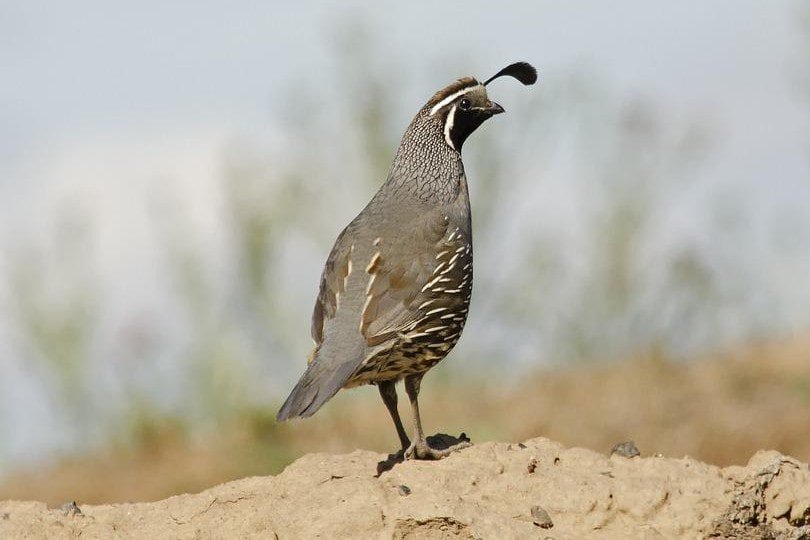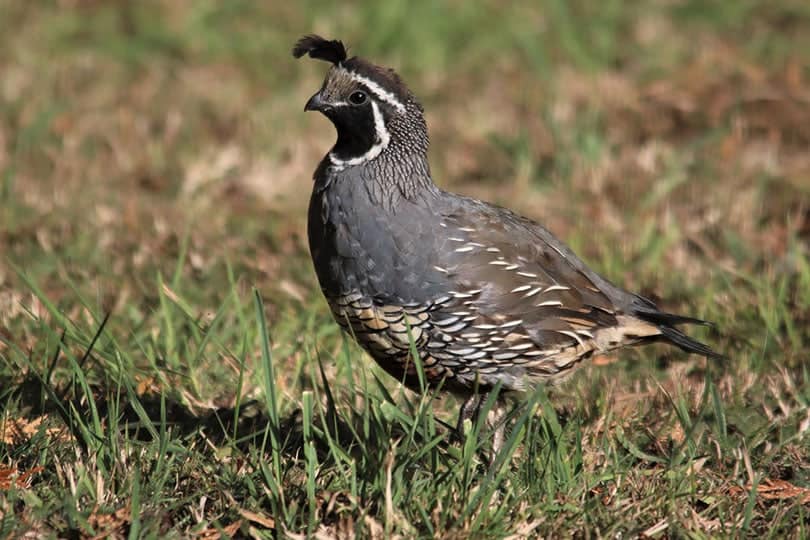The California quail is an attractive, ground-dwelling bird native to the southwestern United States and northern Mexico. It was named California’s state bird in 1931 and co-starred in the animated film Bambi. If you’re lucky enough to spot the quick-moving bird under a tree or shrub, you’ll notice its trademark dark plume that bounces on its head as it moves. California quail are fascinating species, and we’ll discuss the characteristics that make the bird unique.

Quick Facts about California Quail

| Breed Name: | California Quail |
| Place of Origin: | Pacific Coast of the United States |
| Uses: | Pets, game birds |
| (Male) Size: | 5–7 ounces |
| (Female) Size: | 5–6 ounces |
| Color: | Brown or gray/brown feathers, black plume, brown and white speckled flanks |
| Lifespan: | 1–4 years |
| Climate Tolerance: | Coastal plains, desert regions, colder climates in Canada |
| Care Level: | Moderate |
| Production: | 12-16 eggs per year |
| Behavior: | Flies in large convoys except during the mating season |
California Quail Origins
The California quail’s original home range stretched from Baja California to the southern regions of Oregon. They’re genetically similar to Gambel’s quail, but the species separated at least 1 million years ago during the Pleistocene period. Native Americans and settlers of western California used the quail as a food source, but the population has fluctuated significantly in California since the end of the 19th century. In San Francisco, the California Quail were once abundant, but in 2017, only one quail lived in the city. Habitat loss and a large population of feral Golden Gate cats are two possible causes of the quail’s demise in San Francisco.

California Quail Characteristics
Like pigeons, the California quail enjoys foraging on the ground. They spend most of the day looking for food under bushes and small trees. When females construct nests, they find a secretive place under a shrub or near a brush pile. They create a depression in the ground and line it with twigs and grass, and some nests are so well hidden that birdwatchers and researchers have had trouble calculating the number of nests in coastal regions.
Besides the handsome plume of black feathers, one of the bird’s most distinguishing features is its running style. Quails have tiny legs, but they can move up to 12 miles per hour when they feel threatened by predators, and they’re known to get a running start before launching into the air and flying 58 miles per hour. The California quail travels in large convoys that can include over 100 birds during the fall, but the convoy dissolves into mating pairs when the mating season approaches in the spring. However, the couples typically build nests close to other quail families.
Uses
California quail are legal to hunt in California, Nevada, Oregon, and Washington State. The bird is prized for its tender meat, and although it’s the state bird of California, it’s legal to eat and farm the quail in the state. It’s not considered domesticated, but the quail is also popular as a pet. When you raise several birds, you have access to delicious eggs and skilled musicians. California quail make several vocalizations, but their most famous call sounds like they’re singing the word “Chicago.” Male and females make alternating chirps, referred to as antiphonal calling, that combine to form a unique song.
Appearance & Varieties
Males are more colorful than females, and their distinctive plumes are larger and black rather than brown. The plume comprises six feathers, but it looks like a single cord or comma that dangles above the bird’s head. Males and females have similar features, including black facial feathers, but males have black throats and a white stripe on their faces and females have speckled gray throats, and solid black heads. Immature quail lack the speckled white pattern on the breasts like their parents and mostly have dull gray and brown feathers.
Population/Distribution/Habitat
California quail do not migrate, and they maintain a small home range compared to other breeds. Although the quail are native to the southwestern United States and northern Mexico, they’ve been imported to several locations, including Hawaii, Australia, New Zealand, Brazil, South Africa, and Peru, where their populations have flourished.
The birds establish habitats in woodlands, forests, sagebrush, city parks, and neighborhood gardens. They’re tolerant of arid conditions but can also handle frigid weather. Wild bird enthusiasts often sprinkle seeds near backyard bushes to attract quail to their yards.

Are California Quail Good for Small-Scale Farming?
California quail have a short lifespan, but they’re suitable for small-scale farming and homesteads. In the wild, quail usually have one brood per year, but with a constant supply of healthy food, they can produce two broods. They’re not as prolific as chickens with egg production, but hunters and farmers value their high-quality eggs and meat. Although California quail are not considered tame animals, they’re amusing, colorful birds that make excellent pets for adventurous pet owners.
Related bird reads:
Featured Image Credit: Nel Botha, Pixabay
